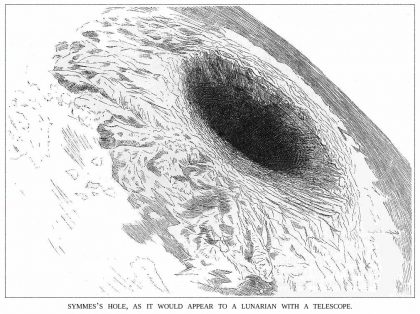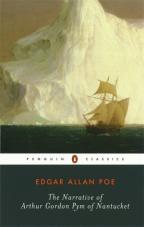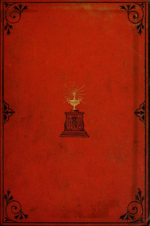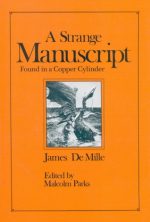A fun idea but, like everything else these days, ruined by racism and Nazis.
One of the great things about scouring sites like Project Gutenberg for free e-books of old speculative fiction, is that you can get a window onto out-there ideas written by respected authors. Perhaps the best example is Journey to the Centre of the Earth, by Jules Verne. This classic is an example of the “Hollow Earth” theory in action. Hollow Earth proponents expounded that there was a vast subterranean world beneath the Earth’s outer layer. Verne’s fiction envisioned a realm large enough to contain underground seas.
This wasn’t just a one-off story idea or short-lived crackpot fad. In the 19th century, it was a semi-serious theory and it resulted in some truly fun and imaginative fiction.
The Origins of the Hollow Earth Theory

The concept of an underworld is as old as mythology. Ancient peoples frequently envisioned a realm of the afterlife beneath the ground, not as a metaphor, but an actual physical place.
Mythological beliefs faded over time. With the scientific revolution, people widely accepted the idea of the Earth as a sphere. But we only saw what was on the surface. What was actually inside, taking up most of the space? This is when the idea of underground worlds came creeping back.
The Hollow Earth idea really took off in the early 1800s. An American named John Cleves Symmes Jr. proposed a detailed theory. He believed that the inner Earth contained concentric spheres, each with its own surface world. Sunlight filtering in through massive holes located at the poles kept these inner spheres warm and livable. He also thought centrifugal forces compressed the Earth at the poles. This meant that the polar regions, being closer to whatever inner heat source fed volcanic activity, were warm, tropical places.
Symmes spent a lot of his own money preaching his theory. He used lecture circuits, leaflets, and letter campaigns to newspapers and magazines. Thanks to his hustle, he had a lasting influence on writers of speculative fiction at the time.
Even in its time, most scientists derided the Hollow Earth theory. When actual polar exploration found no holes, that ended any serious discussion of this theory.
3 Notable Hollow Earth Stories
The Narrative of Arthur Gordon Pym of Nantucket by Edgar Allan Poe (1838)
 Poe’s only completed novel actually takes place entirely on the surface of the Earth. The title character stows away on a whaling ship for adventure. Things go south, literally and figuratively, after a mutiny breaks out. Pym’s eventual journey takes him all the way toward the South Pole. It’s an adventure tale that speculates what might be found at the then-unknown Antarctic pole. Drawing from Hollow Earth theory, Poe imagined tropical lands and chasms opening into the Earth. Unfortunately, Poe also imagined horrific racial caricatures in the natives of these southern lands. Negative racial imagery pervades the rest of the story too, which was sadly all too common to speculative work of this era.
Poe’s only completed novel actually takes place entirely on the surface of the Earth. The title character stows away on a whaling ship for adventure. Things go south, literally and figuratively, after a mutiny breaks out. Pym’s eventual journey takes him all the way toward the South Pole. It’s an adventure tale that speculates what might be found at the then-unknown Antarctic pole. Drawing from Hollow Earth theory, Poe imagined tropical lands and chasms opening into the Earth. Unfortunately, Poe also imagined horrific racial caricatures in the natives of these southern lands. Negative racial imagery pervades the rest of the story too, which was sadly all too common to speculative work of this era.
The Coming Race aka Vril by Edward Bulwer-Lytton (1871)
 Bulwer-Lytton is most famous as the writer who first came up with “it was a dark and stormy night.” This fanciful story is narrated by a man who falls into an underground world after a mining accident. He finds a race of people with telepathic powers, manipulating an energy source called Vril. The Vril-ya, as the people are called, have a “topsy-turvy” world compared to mid-19th century Britain. Women are bigger and stronger and choose whom to marry. The horror!
Bulwer-Lytton is most famous as the writer who first came up with “it was a dark and stormy night.” This fanciful story is narrated by a man who falls into an underground world after a mining accident. He finds a race of people with telepathic powers, manipulating an energy source called Vril. The Vril-ya, as the people are called, have a “topsy-turvy” world compared to mid-19th century Britain. Women are bigger and stronger and choose whom to marry. The horror!
After entangling with forbidden love, the narrator escapes the wrath of the Vril-ya with the help of his lover. The main takeaway is that the Vril-ya will one day run out of space and come up to the surface and wipe out humanity.
This book’s reputation has suffered from its racial undertones and alleged association with the Nazis. It’s easy to see the connections. A superior race that needs to wipe out lesser inhabitants for living space? Yikes! The novel was popular with turn-of-the-century occultists whose ideas seemingly aligned with the Nazis. I’d take this last part with a grain of salt, though, as there’s no evidence of the Nazis believing in Vril or holding this book in any significance.
James De Mille – A Strange Manuscript Found in a Copper Cylinder (1888)
 This work is part of the found manuscript sub-genre, a 19th century precursor to the creepy found footage movies today. This is another novel that envisioned a tropical land close to the South Pole. It is also a topsy-turvy satire, thankfully lacking in racial undertones. Everything in this mysterious southern land was in reverse to our society. Death is the ultimate aspiration, but only awarded early to the deserving. The people shy away from the light. They aspire to poverty. The wealthy are shunned and hated (actually, that part doesn’t sound so crazy, considering what the worship of wealth is doing to this world of ours.)
This work is part of the found manuscript sub-genre, a 19th century precursor to the creepy found footage movies today. This is another novel that envisioned a tropical land close to the South Pole. It is also a topsy-turvy satire, thankfully lacking in racial undertones. Everything in this mysterious southern land was in reverse to our society. Death is the ultimate aspiration, but only awarded early to the deserving. The people shy away from the light. They aspire to poverty. The wealthy are shunned and hated (actually, that part doesn’t sound so crazy, considering what the worship of wealth is doing to this world of ours.)
After another forbidden love entanglement and another escape, we get an abrupt ending. De Mille seemed to be angling for a sequel that never came, since it was published posthumously eight years after his death.
Hollow Earth-ism a theory that persists to this day, thanks to the ongoing devaluation of science. Vice posted a great article about its current proponents. My favourite part of that story is how hollow earthers don’t get along with flat earthers, who seem to be more in favour among conspiracy theorists of late. (Kyrie, what have you done?)
Despite its association with anti-science and the usual undertones of racism, there is something undeniably romantic about this vision of a hidden world right beneath our feet. For some other reading suggestions, including more modern works inspired by the Hollow Earth, check out this article on Unbound Worlds:
http://www.unboundworlds.com/2017/07/want-read-hollow-earth-fiction-heres-start/


This is such a cool blog post! Sharing it.
BTW, have you heard of Hollow World by Michael J. Sullivan? It’s a futuristic tale, and possibly not based on this, but it’s a WONDERFUL book 🙂 truly recommended.
I think I’ll be checking out these books you mentioned.
No, I haven’t heard of Hollow World, thanks for the recommendation! I’ll put it on my list to check out. ?
And thanks for reading this post, I’m glad you found it interesting!